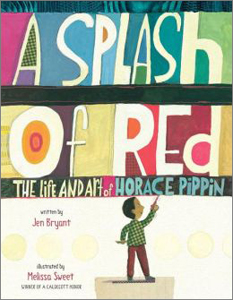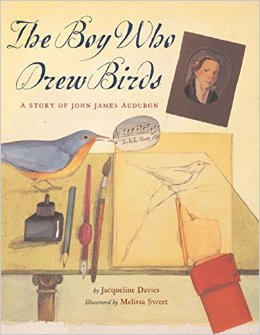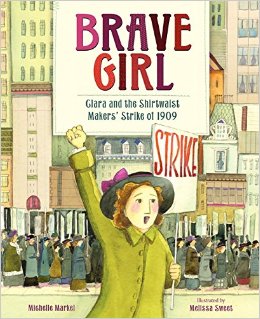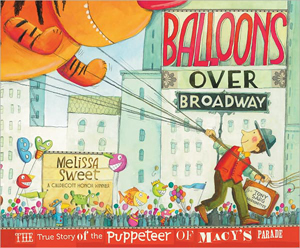2018 School Spending Survey Report
Reviews of select books written and/or illustrated by Melissa Sweet
The Right Word: Roget and His Thesaurus
by Jen Bryant; illus.
 The Right Word: Roget and His Thesaurus
The Right Word: Roget and His Thesaurusby Jen Bryant; illus. by Melissa Sweet
Primary Eerdmans 48 pp.
9/14 978-0-8028-5385-1 $17.50
Apt language and ingenious imagery combine to tell the life story of Peter Mark Roget, creator of the thesaurus. A solitary, though not unhappy, child, Roget spends his time keeping lists and ordering the natural and cultural wonders he finds in abundance. He studies to become a doctor, teaches, joins academic societies, raises a family, and continues to capture and classify the universe, eventually publishing his Thesaurus, a catalog of concepts ordered by ideas, in 1852. Bryant’s linear telling follows Peter closely, expressing his curiosity, sensitivity, and populist spirit in language that is both decorous and warm. Clever book design and visionary illustration add layers of meaning, as images come together in careful sequence. On the cover a cacophony of iconographic ideas explodes from the pages of a book. The opening endpapers arrange these same concepts in a vertical collage that recalls spines on a bookshelf. The title spread features the letters of the alphabet as stacked blocks, as a child manages them, and from there the pages grow in complexity, as Roget himself grows up. Sweet embellishes her own gentle watercolors with all manner of clippings and realia, corralling the pictures into order according to concept, number, or color. A timeline and detailed author and illustrator notes follow the narrative, with suggested additional resources and a facsimile page of Roget’s first, handwritten book of lists. And the closing endpapers, with the comprehensive classification scheme of the first thesaurus, fully realize the opening organizational promise. THOM BARTHELMESS
From the November/December 2014 issue of The Horn Book Magazine.
 A Splash of Red: The Life and Art of Horace Pippin
A Splash of Red: The Life and Art of Horace Pippinby Jen Bryant; illus. by Melissa Sweet
Primary Knopf 40 pp.
1/13 978-0-375-86712-5 $17.99
Library ed. 978-0-375-96712-2 $20.99
Horace Pippin drew and painted from an early age, but as the eldest son in a working-class African American family he was not afforded the luxury of pursuing an education or career in art. Instead, beginning at age fourteen he worked a series of menial jobs to help support his family until he enlisted as a soldier in World War I. There, he sketched and recorded what he saw. When he was shot in the right shoulder, he sustained an injury so grave that he was discharged from the army; it also weakened his right arm to such an extent that it ended his ability to draw or paint. But years later he felt inspired to create art, and he realized he could do so if he supported his right hand with his left one. He went on to create dozens of paintings, based on memories from his childhood and wartime experiences, stories his grandmother had told, stories from the Bible, and scenes he saw around him. Bryant’s well-researched, articulate account of Pippin’s life is interspersed with direct quotes from him, most of which are embedded directly into Sweet’s expressive gouache, watercolor, and collage illustrations. Although only five of Pippin’s actual paintings are reproduced here (and only on the back endpapers), Sweet includes her own versions of many of them, created in the “simple colors” Pippin was fond of—black, white, browns, greens, yellows—but usually including a touch of bright red. KATHLEEN T. HORNING
From the January/February 2013 issue of The Horn Book Magazine.
 The Boy Who Drew Birds: A Story of John James Audubon
The Boy Who Drew Birds: A Story of John James Audubonby Jacqueline Davies; illus. by Melissa Sweet
Primary, Intermediate Houghton 32 pp.
9/04 ISBN 0-618-24343-7 $15.00
Though best known for his precise ornithological paintings, Audubon was also distinguished for scientific curiosity, as dramatized in this slightly fictionalized account of an incident from the French teenager’s earliest time in the United States. No one knew in the early 1800s what became of songbirds in the winter; scientists’ unfounded theories included Aristotle’s guess that they “hibernated under water,” while some of Audubon’s contemporaries “believed that birds transformed from one kind into another.” Though knowledge concerning actual migration paths would await another century, Audubon postulated that the same birds returned each spring and proved it by banding phoebe nestlings with silver thread and finding them, months later, nesting near their natal site. Melissa Sweet’s relaxed watercolor style and skillful incorporation of collage, plus a lively narration that illuminates Audubon’s passion for observation and sets his pivotal insight into context, make this appealing vignette a fine introduction to his work. Author and illustrator source notes and a bibliography are appended. JOANNA RUDGE LONG
From the November/December 2004 issue of The Horn Book Magazine.
 Brave Girl: Clara and the Shirtwaist Makers’ Strike of 1909
Brave Girl: Clara and the Shirtwaist Makers’ Strike of 1909by Michelle Markel; illus. by Melissa Sweet
Primary Balzer + Bray/HarperCollins 32 pp.
2/13 978-0-06-180442-7 $17.99
The plight of early-twentieth-century female garment workers is brought to life in this biography of labor leader Clara Lemlich. To escape persecution in their native Ukraine, the Jewish Lemlichs immigrated to New York City, where young Clara quickly found work in a shirtwaist factory. Outraged by the dangerous and unfair working conditions, Clara successfully instigated a citywide strike. In her simple but powerful text Markel shows how multiple arrests, serious physical attacks, and endless misogyny failed to deter this remarkable woman as she set off on her lifelong path as a union activist. Clara’s story is accentuated by Sweet’s vivid illustrations, many of which are presented on fabric scraps or torn paper with borders of machine stitching. Particularly riveting is a bird’s-eye view of a factory floor filled with hundreds of workers set opposite a series of spot illustrations highlighting some of the dreadful conditions the women endured (including being locked in during the day—the cause of the horrific Triangle shirtwaist factory fire deaths). For those wanting to know more, an author’s note and source notes follow the story. MONICA EDINGER
From the January/February 2013 issue of The Horn Book Magazine.

by Melissa Sweet; illus. by the author
Primary, Intermediate Houghton 40 pp.
11/11 978-0-547-19945-0 $16.99
At Macy’s department store, marionette maker Tony Sarg started inside and worked his way out. He designed mechanical storybook figures for Macy’s window displays before inventing the giant balloon characters that would become the signature feature of the Macy’s Thanksgiving Day Parade. Sweet’s whimsical mixed-media collages, embellished with little dolls she made herself out of odds and ends, reinforce the theme that, for Sarg, work was play. He loved his job just as much as the cheering crowds loved his balloons (one of Sweet’s watercolor illustrations shows open-mouthed children fairly dancing with delight). Sweet runs through the various problems Sarg had to solve before his behemoths could fl y: “He would have to make much larger puppets in order for them to be seen in the parade. And how could he make them strong enough to hold up in bad weather yet light enough to move up and down the streets?” (He hired a blimp manufacturer in Ohio to create his designs out of rubberized silk.) His biggest concern was that the balloons seem animated, that they move like puppets, so he came up with the idea to control them like marionettes, only with the control strings on the bottom instead of the top. Th us, thanks to Tony Sarg, SpongeBob soars. An author’s note and source list are appended. CHRISTINE M. HEPPERMANN
From the November/December 2011 issue of The Horn Book Magazine.

by Melissa Sweet; illus. by the author
Intermediate, Middle School Houghton 164 pp.
10/16 978-0-544-31959-2 $18.99 g
Salutations! Sweet raises her collage skills to new heights while bringing her love and admiration for fellow Mainer E. B. White to the page for everyone to appreciate. Just as her astounding collages blend materials that might have been found in a barn in Maine, the text carefully blends her words with those of the beloved writer of children’s books, New Yorker essays, and The Elements of Style (the essential treatise on grammar, co-written with William Strunk). One can imagine Sweet’s studio filled with snippets of quotations from White’s works ready to find the perfect place on her pages, to meld seamlessly with her words and bring the story of his life to a new generation of readers and admirers. Sweet has written and drawn a fast-moving, thorough, deeply researched, and accessible biography. White’s own words are signaled by a typewriter font, and each quote is accompanied by a simple tan label that sets it off from the main text without being distracting. Charming photographs of young White, whether he is playing the mandolin, gliding in a canoe, or dangling from a log over a river, additionally inform the reader about his childhood and young adulthood, making the origins of his writing come alive. Sweet inserts just the right amount of detail about his personal life (for instance, his wife Katherine Angell divorced in order to marry White) but is never gossipy. In the end, whether readers are weeping at White’s death or smiling at stepson Roger Angell’s wry memorial comments, they will rejoice that Sweet has caught up with an old favorite in White. With this book, we all have. ROBIN SMITH
From the September/October 2016 issue of The Horn Book Magazine.
RELATED
RECOMMENDED
ALREADY A SUBSCRIBER? LOG IN
We are currently offering this content for free. Sign up now to activate your personal profile, where you can save articles for future viewing.







Add Comment :-
Be the first reader to comment.
Comment Policy:
Comment should not be empty !!!